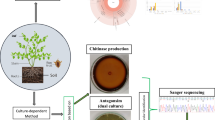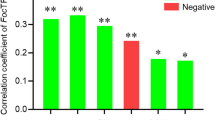Abstract
Biological soil disinfestation (BSD) involves elimination of soil-borne plant pathogens in an environmentally friendly manner. Two anaerobic bacterial strains (H110 and TB8) isolated from BSD-treated soil samples were analyzed for their roles in elimination of pathogenic fungi. The two strains were identified as Clostridium beijerinckii based on 16S rRNA gene sequences and phenotypic properties. The strains fermented various carbohydrates and produced acetate, butyrate, and n-butanol as major products as well as abundant gases (H2 and CO2). For evaluation of the antifungal potential of these strains, cells of a pathogen (spinach wilt disease, Fusarium oxysporum f. sp. spinaciae) were co-inoculated into anaerobic media with each anaerobic strain. After incubation for ~3 weeks at 30 °C, 10–30% of the cells of the pathogen survived when incubated without the anaerobic isolates, whereas the pathogen was eliminated when co-incubated with each anaerobe because of the growth of the anaerobic bacterium. It was found by microscopic examination that mycelial cells of the fungal pathogen were severely degraded during the first 3–7 days of the co-incubation. The two strains utilized major cell wall polysaccharides of ascomycetous fungi—chitosan and ß-1,3-glucan (curdlan and laminarin)—as fermentative substrates added to the medium. Furthermore, both isolates degraded a cell wall preparation isolated from the mycelium of the Fusarium pathogen of spinach wilt disease. We concluded that the two anaerobic strains kill the pathogen of spinach wilt disease by degrading major fungal cell wall components as antifungal activities.



Similar content being viewed by others
References
Altschul SF, Madden TL, Schäffer AA, Zhang J, Zhang Z, Miller W, Lipman DJ (1997) Gapped BLAST and PSI-BLAST: a new generation of protein database search programs. Nucleic Acids Res 25:3389–3402
Aktuganov GE, Galimzyanova NF, Melent’ev AI, Kuz’mina LY (2007) Extracellular hydrolases of strain Bacillus sp. 739 and their involvement in the lysis of micromycete cell walls. Microbiology 76:471–479
Bailey KL, Lazarovits G (2003) Suppressing soil borne diseases with residue management and organic amendments. Soil Till Res 72:169–180
Blok WJ, Lamers JG, Termorshuizen AJ, Bollen GJ (2000) Control of soil-borne plant pathogens by incorporating fresh organic amendments followed by tarping. Phytopathology 90:253–259
Dvortsov IA, Lunina NA, Chekanovskaya LA, Schwarz WH, Zverlov VV, Velikodvorskaya GA (2009) Carbohydrate-binding properties of a separately folding protein module from ß-1,3-glucanase Lic16A of Clostridium thermocellum. Microbiology 155:2442–2449
Evvyernie D, Yamazaki S, Morimoto K, Karita S, Kimura T, Sakka K, Ohmiya K (2000) Identification and characterization of Clostridium paraputrificum M-21, a chitinolytic, mesophilic and hydrogen-producing bacterium. J Biosci Bioeng 89:596–601
Goud JKC, Termorshuizen AJ, Blok WJ, van Bruggen AHC (2004) Long-term effect of biological soil disinfestation on Verticillium wilt. Plant Dis 88:688–694
Holdeman LV, Cato EP, Moore WEC (1977) Anaerobe laboratory manual, 4th edn. Virginia Polytechnic Institute and State University, Blacksburg
Kirkegaard JA, Wong PTW, Desmarchelier JM (1996) In-vitro suppression of fungal root pathogens of cereals by Brassica tissues. Plant Pathol 45:593–603
Kurakake M, Yamanouchi Y, Kinohara K, Moriyama S (2013) Enzymatic properties of ß-1,3-glucanase from Streptomyces sp Mo. J Food Sci 78:C502–C506
Macfarlane J, Macfarlane GT (1995) Proteolysis and amino acid fermentation. In: Gibson GR, Macfarlane GT (eds) Human colonic bacteria. CRC Press, New York, pp 75–100
Messiha NAS, van Diepeningen AD, Wenneker M, van Beuningen AR, Janse JD, Coenen TGC, Termorshuizen AJ, van Bruggen AHC, Blok WJ (2007) Biological soil disinfestation (BSD), a new control method for potato brown rot, caused by Ralstonia solanacearum race 3 biovar 2. Eur J Plant Pathol 117:403–415
Momma N (2008) Biological soil disinfestation (BSD) of soil-borne pathogens and its possible mechanisms. JARQ 42:7–12
Momma N, Kobara Y, Uematsu S, Kita N, Shinmura A (2013) Development of biological soil disinfestations in Japan. Appl Microbiol Biotechnol 97:3801–3809
Mowlick S, Hirota K, Takehara T, Kaku N, Ueki K, Ueki A (2012) Development of anaerobic bacterial community consisted of diverse clostridial species during biological soil disinfestations amended with plant biomass. Soil Sci Plant Nutr 58:273–287
Mowlick S, Takehara T, Kaku N, Ueki K, Ueki A (2013a) Proliferation of diversified clostridial species during biological soil disinfestation incorporated with plant biomass under various conditions. Appl Microbiol Biotechnol 97:8365–8379
Mowlick S, Inoue T, Takehara T, Kaku N, Ueki K, Ueki A (2013b) Changes and recovery of soil bacterial communities influenced by biological soil disinfestation as compared with chloropicrin-treatment. AMB Express 3:46
Mowlick S, Yasukawa H, Inoue T, Takehara T, Kaku N, Ueki K, Ueki A (2013c) Suppression of spinach wilt disease by biological soil disinfestation incorporated with Brassica juncea plants in association with changes in soil bacterial communities. Crop Prot 54:185–193
Mowlick S, Inoue T, Takehara T, Tonouchi A, Kaku N, Ueki K, Ueki A (2014) Usefulness of Japanese-radish residue in biological soil disinfestation to suppress spinach wilt disease accompanying with proliferation of soil bacteria in the Firmicutes. Crop Prot 61:64–73
Prasanna R, Nain L, Tripathi R, Gupta V, Chaudhary V, Middha S, Joshi M, Ancha R, Kaushik BD (2008) Evaluation of fungicidal activity of extracellular filtrates of cyanobacteria—possible role of hydrolytic enzymes. J Basic Microbiol 48:186–194
Prather MJ, McElroy MB, Wofsy SC (1984) Reductions in ozone at high concentrations of stratospheric halogens. Nature 312:227–231
Rainey FA, Hollen BJ, Small A (2009) Genus I. Clostridium Prazmowski 1880, 23AL. In: Whitman WB, Parte AC (eds) Bergey’s manual of systematic bacteriology, vol 3. Springer, New York, pp 736–828
Ruiz-Herrera J, Ortiz-Castellanos L (2010) Analysis of the phylogenetic relationships and evolution of the cell walls from yeasts and fungi. FEMS Yeast Res 10:225–243
Saitou N, Nei M (1987) The neighbor-joining method: a new method for reconstructing phylogenetic trees. Mol Biol Evol 4:406–425
Satoh A, Watanabe M, Ueki A, Ueki K (2002) Physiological properties and phylogenetic affiliations of anaerobic bacteria isolated from roots of rice plants cultivated on a paddy field. Anaerobe 8:233–246
Schoffelmeer EAM, Klis FM, Sietsma JH, Cornelissen BJC (1999) The cell wall of Fusarium oxysporum. Fungal Genet Biol 27:275–282
Shinmura A (2000) Causal agent and control of root rot of welsh onion. PSJ Soilborne DiseaseWorkshop Report 20:133–143 (in Japanese with English Summary)
Shinmura A (2004) Principle and effect of soil sterilization method by reducing redox potential of soil. PSJ Soilborne Disease Workshop Report 22:2–12 (in Japanese with English Summary)
Subbarao KV (2002) Methyl bromide alternatives—meeting the deadline. Phytopathology 92:1334–1343
Takehara T, Kuniyasu K, Mori M, Hagiwara H (2003) Use of a nitrate-nonutilizing mutant and selective media to examine population dynamics of Fusarium oxysporum f. sp. spinaciae in soil. Phytopathology 93:1173–1181
Thompson JD, Higgins DG, Gibson TJ (1994) CLUSTALW: improving the sensitivity of progressive multiple sequence alignment through sequence weighting, position-specific gap penalties and weight matrix choice. Nucleic Acids Res 22:4673–4680
Ueki A, Abe K, Suzuki D, Kaku N, Watanabe K, Ueki K (2009) Anaerosphaera aminiphila gen. nov., sp. nov., a glutamate-degrading, Gram-positive anaerobic coccus isolated from a methanogenic reactor treating cattle waste. Int J Syst Evol Microbiol 59:3161–3167
Ueki A, Ohtaki Y, Kaku UK (2016) Descriptions of Anaerotaenia torta gen. nov., sp. nov. and Anaerocolumna cellulosilytica gen. nov., sp. nov. isolated from a methanogenic reactor of cattle waste and reclassification of Clostridium aminovalericum, Clostridium jejuense and Clostridium xylanovorans as Anaerocolumna species. Int J Syst Evol Microbiol 66:2936–2943
Acknowledgements
This study was supported by a grant from the Ministry of Agriculture, Forestry and Fisheries of Japan (Science and Technology Research Promotion Program for Agriculture, Forestry, Fisheries and Food Industry, No. 27016C). We wish to thank Ms. Y. Ohtaki for technical assistance.
Author information
Authors and Affiliations
Corresponding author
Ethics declarations
Competing interests
The authors declare that they have no competing interest.
Ethical approval
This article does not contain any studies concerned with experimentation on human or animals.
Rights and permissions
About this article
Cite this article
Ueki, A., Takehara, T., Ishioka, G. et al. Degradation of the fungal cell wall by clostridial strains isolated from soil subjected to biological soil disinfestation and biocontrol of Fusarium wilt disease of spinach. Appl Microbiol Biotechnol 101, 8267–8277 (2017). https://doi.org/10.1007/s00253-017-8543-7
Received:
Revised:
Accepted:
Published:
Issue Date:
DOI: https://doi.org/10.1007/s00253-017-8543-7




